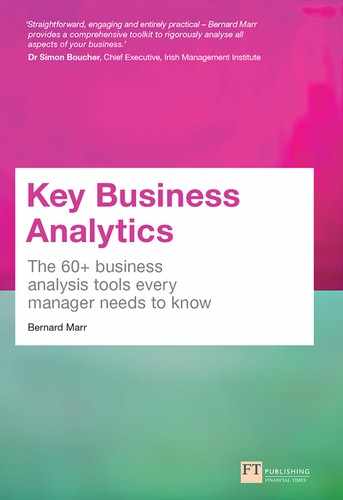48
Social media analytics
What is it?
Social media analytics is the process of gathering and analysing data from social media. The rise of social media has created a rich vein of data from individuals who are customers or potential customers. Most people have a Smartphone and will share their thoughts and feelings regularly via Facebook, Twitter or many of the other social media platforms. This data can then be assessed to find out what people are saying about your product, service, brand or company.
Why does it matter?
Social media analytics matters because it offers you an almost real-time glimpse into what your customers or potential customers think and feel about your business.
These insights can be used to increase revenue by tapping into unmet customer needs (Chapter 34), reduce customer service costs and highlight customer service issues that cause loss of business or reputation. They can also be used by product development to gain real-world feedback on products and services. Often in focus groups (Chapter 21) people will tell you what they think you want to hear or will tone down their dissatisfaction because they don’t want to ‘appear rude’. Social media analytics can give you the real unadulterated view – for better or for worse. Whether good or bad, the truth allows you to take action and improve performance or improve on the product in a way that will resonate with your customers.
Plus, if you don’t know what people are saying about your company or products, you can’t step in to solve the issue or turn an unhappy customer into a raving fan.
When do I use it?
Social media is a permanent and almost constant feature in millions of people’s lives. Those millions of people are posting their opinion on social media via their Smartphones and tablets constantly, therefore you should be analysing what’s being said constantly.
Many big businesses have social media command centres that are monitoring their products, services and brands constantly and using those insights to inform decision making and direct strategy. But it’s not just for big business – social media analytics is essential for all businesses, large and small.
What business questions is it helping me to answer?
Social media analytics helps you answer business questions such as:
- What are our customers saying about the company/brand/product?
- Are our customers satisfied with their interaction with our business or not?
- Are there any problems or issues being raised by our customers on social media that we can solve?
- If you are engaging in social media – who is reading your posts?
- How many followers do you have on Twitter or LinkedIn, or how many likes do you have on Facebook?
How do I use it?
Social media analytics essentially gathers text data from social media posts and blogs and that data is then mined (Chapter 6) for commercially relevant insights.
This can include text analytics (Chapter 8) and sentiment analysis (Chapter 9). Sentiment analysis is one of the most common social media analytic tools as it determines whether customers or potential customers see your brand, product or service positively or negatively, and these trends can aid decision making.
You should know the trends around your product or service every week. There are many tools available to help you achieve this such as Google Social Analytics, SumAll, Facebook Insights and Twitter Analytics.
Practical example
Since 2010 sports drink company Gatorade have operated a social media command centre inside its Chicago HQ. Monitoring their brand in real time across social media platforms and the blogosphere has proved invaluable to the company.
Monitoring their ‘Gatorade has evolved’ campaign, which featured a song by rap artist David Banner, they were able to see that the song was being heavily discussed on social media. Within 24 hours, they had worked with Banner to put out a full-length version of the song and distribute it to Gatorade followers and fans on Twitter and Facebook, respectively. The company is also using the insights from the social media command centre to optimise landing pages and ensure followers are being sent to the top-performing pages. As an example, the company says it’s been able to increase engagement with its product education (mostly video) by 250 per cent and reduce its exit rate from 25 to 9 per cent.1
Tips and traps
The real power of social media analytics is its real-time immediate nature. If you can spot unhappy customers as soon as they indicate their frustration then you have an opportunity to turn that situation around and create a loyal customer. That means you need to use it and look at it frequently because the ‘shelf life’ of the insights are short or potentially short. In addition you need to empower your customer service team to engage with your customers quickly to solve issues.
The biggest trap for social media analytics is to become obsessed with numbers – how many followers or how many Facebook ‘likes’ you have, rather than looking more closely to see how many of those followers are customers and how to engage the audience to encourage more people to purchase your products or services.
Further reading and references
To learn more about social media analytics see for example:
- Sponder, M. (2013) Social Media Analytics: Effective Tools for Building, Interpreting, and Using Metrics, New York: McGraw-Hill
- Russell, M.A. (2013) Mining the Social Web: Data Mining Facebook, Twitter, LinkedIn, Google+, GitHub, and More, 2nd edition, Sebastopol, CA: O’Reilly Media
- Danneman, N. and Heimann, R. (2014) Social Media Mining with R, Birmingham, UK: Packt Publishing
- http://www.sas.com/en_us/software/customer-intelligence/social-media-analytics.html
- http://venturebeat.com/2013/12/20/top-10-social-media-analytics-tools-the-venturebeat-index/
- http://mashable.com/2012/02/09/social-media-analytics-spreadsheets/
- http://www.salesforce.com/uk/socialsuccess/social-media-how-to-guides/social-media-analytics-guide-metrics-tools.jsp
- http://www.goldbachinteractive.com/current-news/technical-papers/social-media-monitoring-how-it-s-done
- http://www.entrepreneur.com/article/239029
- http://www.razorsocial.com/social-media-analytics-tools
_________________
1Ostrow, A. (2010) ‘Inside Gatorade’s Social Media Command Center Mashable’, http://mashable.com/2010/06/15/gatorade-social-media-mission-control/
